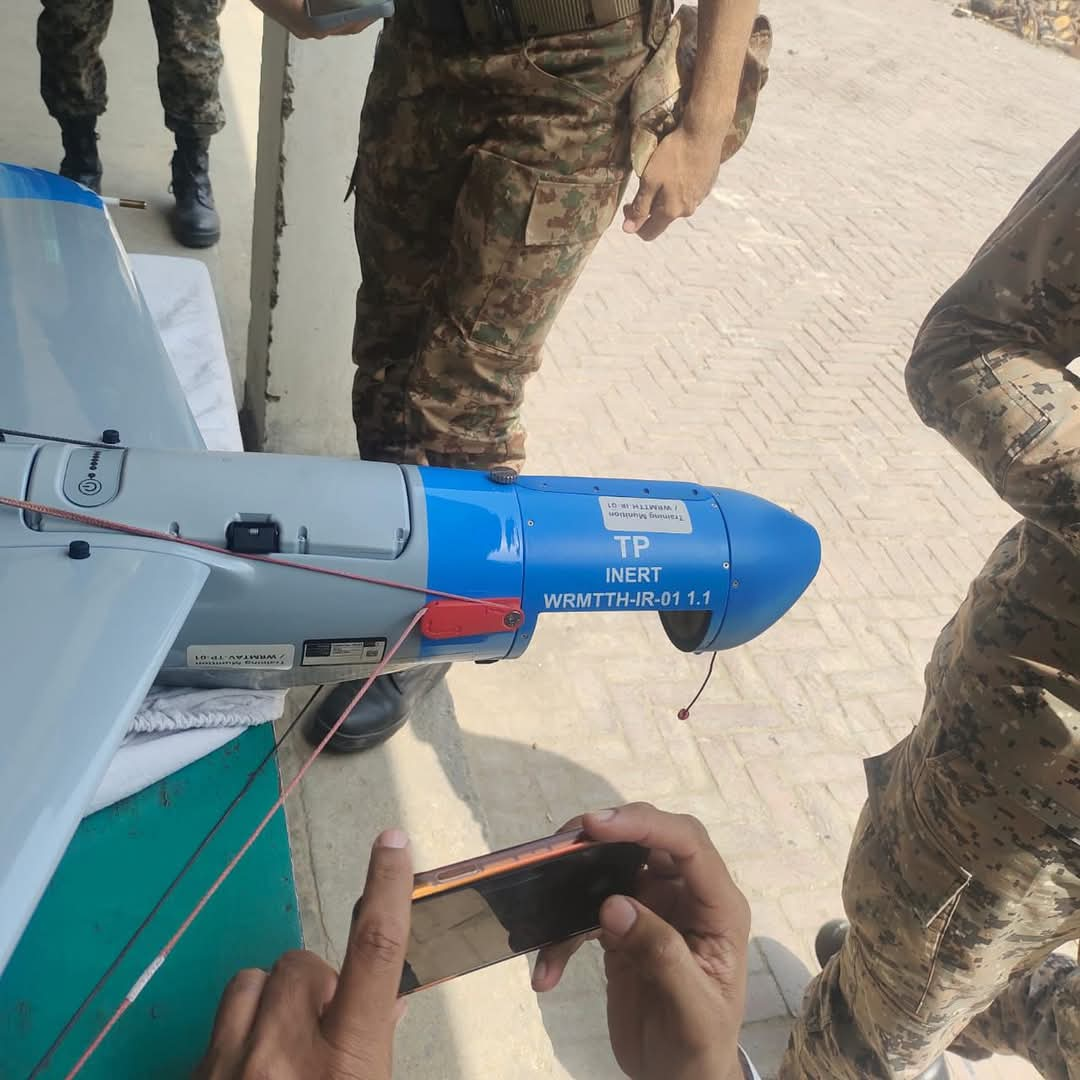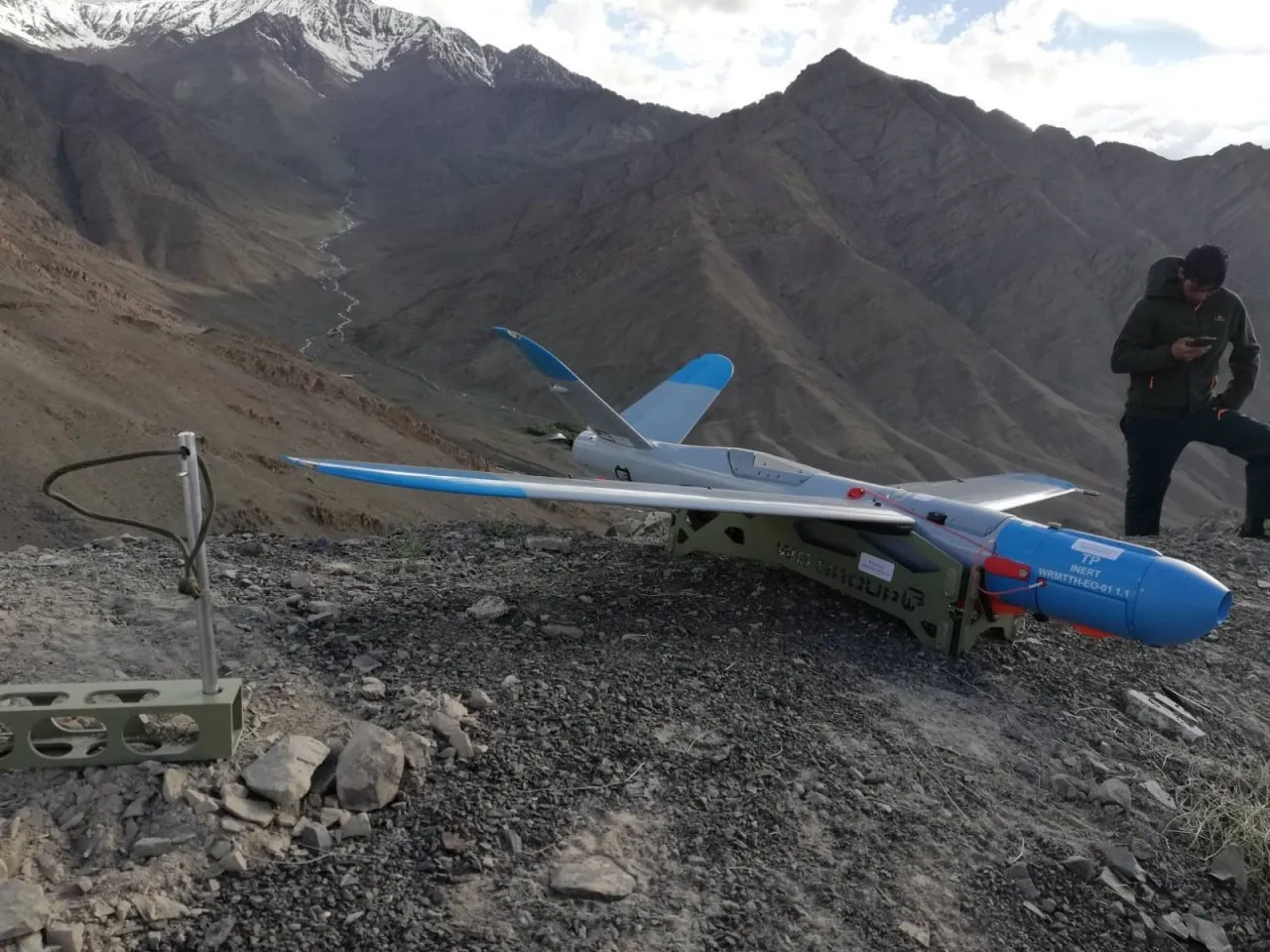Pakistan’s Electronic Ambush: Indian Warmate Drone Captured Intact in EW Intercept
Military sources confirm the drone sustained no physical damage, enabling detailed forensic analysis and the potential for reverse-engineering its command architecture, flight control software, and sensor payload—capabilities that could provide an intelligence windfall to Pakistan’s defence-industrial base.
(DEFENCE SECURITY ASIA) – In a dramatic demonstration of its electronic warfare prowess, Pakistan has reportedly used a “soft-kill” electronic countermeasure to bring down an Indian Army-operated WARMATE loitering munition drone without firing a single shot.
The captured drone, a Polish-manufactured tactical loitering munition designed for precision strikes, was discovered fully intact in the vicinity of Lahore Airport, offering Pakistan a rare opportunity to study an adversary’s operational system in pristine condition.
Military sources confirm the drone sustained no physical damage, enabling detailed forensic analysis and the potential for reverse-engineering its command architecture, flight control software, and sensor payload—capabilities that could provide an intelligence windfall to Pakistan’s defence-industrial base.
Indian forces have been deploying WARMATE drones during the recent cross-border skirmishes, reportedly using them to target forward-operating Pakistani military infrastructure before a temporary ceasefire came into effect.
Footage and images circulating widely on Pakistani social media platforms show the drone being recovered intact, drawing widespread attention for what appears to be a textbook example of non-kinetic aerial interdiction.
“The drone was neutralized without a warhead and appeared to be used primarily for ISR [Intelligence, Surveillance and Reconnaissance] tasks,” stated defence officials, suggesting it was likely deployed to map target coordinates or gather battlefield imagery rather than conduct a strike.
Pakistan’s growing electronic warfare capability—spanning airborne, ground-based, and mobile systems—has been central to its efforts to counter India’s conventional superiority in areas such as manned aircraft and standoff weaponry.

Islamabad has acquired and co-developed a suite of mobile electronic countermeasure (ECM) platforms in collaboration with China, tailored specifically for frontline engagement where jamming enemy communications, GPS signals, and airborne radar suppression are critical.
These systems are also engineered to execute tactical airspace denial and conduct deceptive signal operations to disrupt Indian command-and-control networks during both air and ground-based confrontations.
In parallel, Pakistan’s Defence Science and Technology Organization (DESTO) is believed to have developed indigenous EW ground stations capable of signals intelligence (SIGINT) and communications interception (COMINT), providing real-time tactical awareness and electronic dominance in conflict zones like Kashmir and Gilgit-Baltistan.
The Indian Army’s use of the WARMATE platform underscores New Delhi’s increasing reliance on loitering munitions and unmanned systems to conduct precision missions in contested zones where manned aircraft operations face terrain and political constraints.
Developed by Poland’s WB Electronics, the WARMATE is a man-portable, electrically powered kamikaze drone that can carry out both surveillance and strike missions against lightly protected targets, static infantry, and soft-skinned vehicles.
The system’s design fills the tactical void between micro-UAVs and larger strategic loitering drones such as the Israeli HAROP or U.S. Switchblade, offering a cost-effective, rapid-deployment tool for frontline troops in dynamic theatres.

Weighing 5.7 kg with a wingspan of 1.6 meters, the WARMATE can be launched manually or via a pneumatic catapult, and is configurable with high-explosive (HE-FRAG), anti-armor (HEAT), or thermobaric warheads, depending on mission parameters.
In flight, it relies on electro-optical and infrared sensors to identify, track, and verify targets before diving at high speed into the selected threat point, delivering lethal precision with a circular error probability (CEP) of just 1.5 meters.
These features make the drone particularly effective in urban combat and mountainous terrain, where line-of-sight targeting and minimal collateral damage are mission priorities.
Indian defence officials have indicated that the WARMATE is currently fielded by Para Special Forces and high-altitude infantry units operating in Ladakh, where adverse weather and rugged geography often limit traditional air support.
Military analysts view India’s embrace of kamikaze drones as part of a broader doctrine to achieve “sensor-to-shooter” compression, where target acquisition and engagement occur in near real-time without direct human exposure to the front lines.
Strategists point to key lessons from the 2020 Nagorno-Karabakh war and the ongoing Russia-Ukraine conflict, where loitering munitions have played a decisive role in altering the tactical landscape by enabling asymmetric precision strikes at relatively low cost.

India’s induction of the WARMATE is also part of a wider effort to integrate Unmanned Combat Aerial Systems (UCAS) into its tri-service operational doctrine, reflecting the global trend toward autonomous warfare and AI-assisted targeting.
The technical specifications of the WARMATE reflect its battlefield flexibility and modular lethality:
WARMATE – Technical Profile
-
Length: 1.1 meters
-
Wingspan: 1.6 meters
-
Empty Weight: 4.0 kg
-
Maximum Takeoff Weight: 5.7 kg
-
Cruising Speed: 80 km/h
-
Top Attack Speed: 150 km/h
-
Operational Range: 30 km (Line-of-Sight)
-
Flight Time: Up to 60 minutes
-
Operational Altitude: 150–300 meters AGL
-
Maximum Altitude: 3,000 meters ASL
-
Propulsion: Electric motor
-
CEP: 1.5 meters
Warhead Options:
-
HE-FRAG: 300g TNT-based high-explosive with fragmentation; effective against infantry and soft vehicles.
-
HEAT: Anti-tank warhead with 200–240 mm RHA penetration; suitable for armored targets.
-
Thermobaric: Volumetric explosive ideal for bunkers and enclosed structures.

The estimated unit cost of each WARMATE drone, including payload, is approximately $12,000 USD (roughly RM56,000), making it one of the most affordable loitering munitions on the market.
Reports suggest India has procured over 100 units, deploying them across high-risk theatres along both the China and Pakistan borders, where tactical flexibility and deniability are operational priorities.
The downing of the WARMATE drone near Lahore signals not just a technical victory for Pakistan’s EW ecosystem, but also underscores the emerging dominance of non-kinetic warfare in shaping 21st-century combat dynamics in South Asia.
As drone warfare continues to redefine battlefield engagement rules, the WARMATE incident may mark the beginning of a new digital arms race in the skies over the Subcontinent—one where bytes, not bullets, determine superiority.
— DEFENCE SECURITY ASIA


